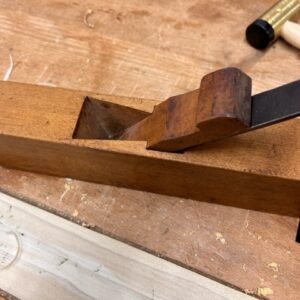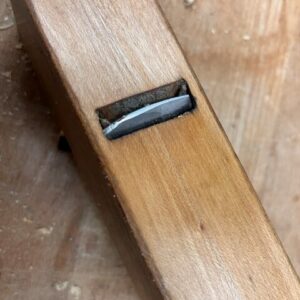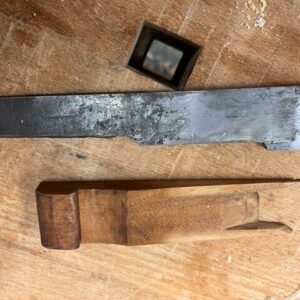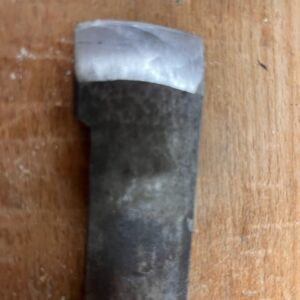I have an antique wooden hand plane, I believe it’s a scrub plane. It actually cut fairly well although it looked like it hadn’t been sharpened in a century and most likely with a file, not a stone. The blade appeared to have a convex, not concave (wheel ground) tip, but at this point I can’t be 100% certain.
Because I’m a genius I decided to regrind the iron with a slight (much less) camber on a wheel and sharpen on a series of water stones as I would any other iron, including a small micro-bevel. Disaster!
Now it won’t cut AT ALL and I can’t remember if the iron is to be installed bevel down or bevel up. I’m pretty sure it was bevel down.
Not the end of the world but I’m upset I wrecked (hopefully temporarily) what was a working plane.



















Replies
Bevel down should be the correct way. In terms of how to sharpen this. Likely freehand with this kind of radius. I'd go watch some Paul Sellers videos on sharpening. Should help.
Thanks. Is it possible the blade could have been ground convex?
As Joe suggested, bevel down would be correct. I would regrind the bevel on a grinder at an angle where the the edge contacts the wood, not the back of the bevel—30 degrees should work. Grind all the way to the tip, keeping it cool. Leave it hollow ground. I wouldn't refine the edge yet. I would see if that will cut. Once that is cutting then you can refine the edge. If it fails to cut after that, the problem is in the honing process. Curved edges are harder to maintain the honing angle. Setting the blade can be finicky but with a tap here and there, aim to just getting the blade to cut. Too much and the plane will buck trying to cut too big a shaving.
Thanks.
Sorry, not sure what you mean “where the edge contacts the wood”. The entire edge would contact the wood.
The cutting angle on any bevel-down plane is the angle cut or cast into the plane body. Changing the bevel angle on the cutting iron will not affect cutting action of the plane unless it is greater than the cutting angle. Then the back edge of the bevel is hitting the wood, not the cutting edge of the bevel. I would check that the micro-bevel hasn’t exceeded the cutting angle. Micro-bevels on the bevel side are unnecessary on any bevel down plane. You just need to refine/polish the cutting edge using whatever method suits you. Lastly, scrub planes need a big throat because the chips you are cutting are on the large size.
Concave comes from using a grinder. The convex shape comes from the natural motion of sharpening exclusively by hand. I know Paul Sellers has written and blogged a bunch about this over the years. Each way works. Sharpening starts to become a religion to many people. There are many ways and mediums that all work well. I know for my scrub plane and gouges, given the radii involved, I go slow and sharpen by hand. The good news is that for a scrub plane, you don't need to have the level of sharpness as refined as your other planes since it is doing rough work. Obviously you don't want it dull either. It's a good blade to practice sharpening by hand. Sharpening by figure eights or side to side are the two most common techniques folks use on highly cambered blades.
The blade, from side to side should be cambered -- ground convex. I took a piece of wood the width of the blade, and used a compass set to an 8 or 10 inch radius, and drew it on the wood. I used a sander to round the wood to that radius. This is your scrub plane grinding template. Trace the shape onto the end of the blade.
The shape should be symmetrical. Yours is very lopsided. Once you have a symmetric end, grind the bevel, at around 25-30 degrees. The bevel can be flat, or hollow ground. Some people call the bevel convex or concave, but I think that's misleading. The bevel shouldn't have a belly. That can keep the actual edge from contacting the wood. Flat bevel, as it comes from a sanding belt or very course stone. Or hollow ground, if you use a bench grinder or Tormek.
Once all that is done, use stones or a tormek or similar to hone the actual edge. 35 degrees is what I use for all bevel down planes.
Thanks. The photos were taken before I started my sharpening work. Yes, the blade looked very asymmetrical, one reason I wanted to redefine the leading edge. Not sure why it cut so well.
I like the idea of creating a wooden template, I’ll do that.
I've gone to 35 degrees on all my bevel down plane blades as well as my chisels. At some point, I want to make one pairing chisel with a 20 degree bevel but I'm not in a rush.